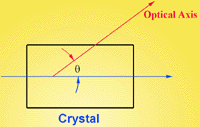|
Sum
Frequency Generation
Differential-Frequency
Generation
Optical
Parametric Generation
Phase Matching
Conversion
Efficiency
Angle
Tilting
Optimum
Crystal Cut
Crystal
Size
Brewster's
angle
Handle
A NLO Crystal
|
|
Phase-Matching
|
|
In
order to obtain high conversion efficiency, the phase vectors
of input beams and generated beams have to be matched:¡¡
Dk
= k3 - k2 - k1 = 2pn3/l3
- 2pn2/l2
- 2pn1/l1
= 0 (for
sum frequency generation)
|
| |
|
|
Where:Dk
is phase mismatching, ki is phase vector at li
and ni is refractive index at li.
In low power
case, the relationship between conversion efficiency and phase
mismatching is:
|
|
h¡Ø[(sinDkL)/DkL]2
|
|
It is clear that
the conversion efficiency will drop dramatically if Dk
increases.
|
| |
|

Critical
Phase Matching
|
The
phase-matching can be obtained by angle tilting, temperature
tuning or other methods. The angle tilting is mostly
used to obtain phase-matching as shown in the left figure.
If the angle between optical axis and beam propagation
(q)
isn't equal to 90o or 0o, we call
it critical phase-matching (CPM). Otherwise,
90o non-critical phase-matching
(NCPM) is for q=90o
and 0o NCPM is for q=0o.
|
Two
types of phase-matching are classified in consideration of
polarization of lasers. If the polarizations of two input
beams (for sum frequency) are parallel to each other, it is
called type I phase-matching. If the polarizations
are perpendicular to each other, it is called type II phase-matching
|
 |
 |
| type
I phase-matching |
type
I phase-matching |
|

